Disney Dark: 13 Disturbing Disney Secrets
1. Human Remains at Disneyland
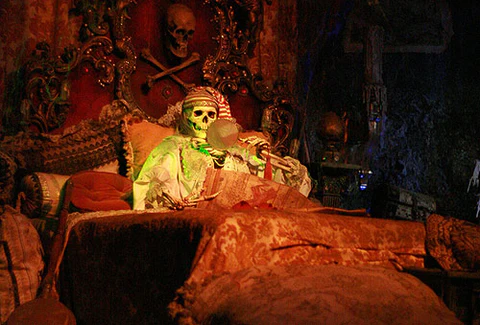
While it is common knowledge that members of the public attempt to scatter the remains of their loved ones at Disneyland every year, our number one most disturbing Disney secret is the confirmation of human remains, resting within the park grounds. Disney officials have confirmed that there is a partial skeleton on display within the ‘Pirates of the Caribbean’ ride in New Orleans Square that once belonged to a live person.
In the 1960s, after Walt’s passing, Disneyland designers decided that the construction of the pirate themed ride did not look as authentic as it should have with the addition of the fake skeletons that adorned the displays inside the attraction. In attempting to resolve the situation, the Imagineers obtained human skeletal remains from the UCLA medical center which they felt provided a creepier, more convincing atmosphere.
While it is unclear when these bones were removed, they remained for some time, and were viewed as part of the ride before eventually being removed and replaced by fake skeletons. However, park workers have confirmed that not all of the bones were removed. The skull and crossbones which hang above the bed in the treasure room are still genuine human skeletal parts.
We think that housing a dead body within one of the rides, makes for a pretty eerie boat ride, and choosing to leave the parts there makes this disturbing Disney secret our number one on the list!
2. Nazi Disney
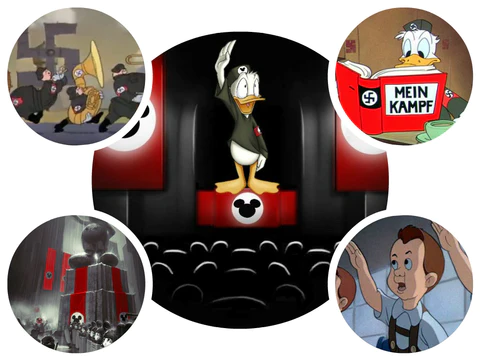
Not much is more disturbing than Nazism, and even more disturbing is that in the height of Nazi Germany’s decision to action a ‘final solution’ to the ‘Jewish problem’ even Disney was engaging in Nazism.
1942 marks the release of Disney’s short animated film titled ‘Der Fuehrer’s Face’. The film follows Donald Duck who is working as a soldier dealing with Nazi food rations and enduring a rather laborious job in an artillery factory. Though the film was one in a long line of propaganda films released by The Walt Disney Company, it is often cited by fans as one of the ‘darker’ moments in Disney’s history because of its depiction of Donald Duck as a Nazi (though a reluctant one). Interestingly, it even scored itself an Academy Award, but was not publically released into the general market due to its controversial subject matters.
Disney is also claimed to have engaged in Nazism in 1994 with the release of The Lion King. The scene in the film where Scar has his moment in the musical limelight for his number ‘Be Prepared’ is rumoured to be directly inspired by footage from a 1935 Nazi propaganda film titled ‘Triumph of the Will.’ The hyenas depicted in the scene represent Nazi soldiers, while Scar, who is seated at the top of a cliff is said to represent Adolf Hitler, standing on the podium overlooking his troops.
3. Club 33
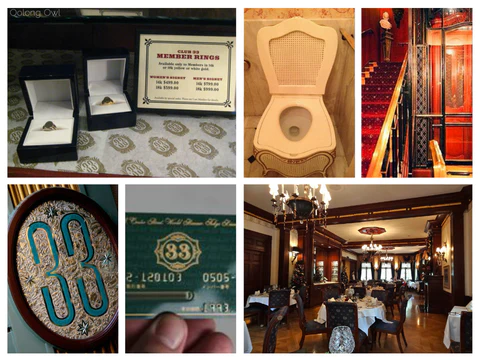
Club 33 is not only hailed as being the most private, mysterious place in the Disney world, it is also one of the most secretive and unexplained locations on the planet.
Formerly known as ‘Walt Disney Club 33,’ is an exclusive society located in the heart of Disneyland’s New Orleans Square and is accessible only to its members. In order to become a member of this exclusive organisation, one must enter the 800 member waiting list (which at last count was estimated to be around a 14 year wait) and fork over a $25,000 initial fee in addition to a commitment to the annual dues of $11,000 required to maintain your membership standing.
In exchange for your fees you receive several things:
- An identification card
- A premier passport for yourself and three guests, valid at Disneyland and Walt Disney World
- The ability to have a drink at Disneyland, since Club 33 is the only location within the park that serves alcohol
- The company of a Disney cast escort throughout the park
- The chance to hang out with celebrities like Mickey Rooney and Mira Sorvino, who have both been spotted inside the club
Once you have selected to take up membership and your fees have been settled, you are able to access the club by pressing the buzzer on the door and speaking through the intercom which is concealed by a hidden panel in the doorway. Once inside you will be in the company of many of the famous Disney props that furnish the club including the glass telephone booth used in The Happiest Millionaire and a white marble table seen in Mary Poppins.
But what goes on inside the club? Nobody quite knows, because those who have been inside don’t discuss the activities they engaged in. The most popular theories are to do with freemasonry and brothel activity. The first is due to the club’s name – 33. Historians are divided as to whether the club was named after its address (33 Royal Street), the list of Disneyland’s 33 corporate sponsors at the time of opening or the 33rd degree – the highest level in Scottish Rite Freemasonry. The second theory has abounded since the club’s opening as Walt himself stated that he designed the club as a space where the park could entertain dignitaries such as Bobby Kennedy. It is rumoured the high class hookers were also invited to parties which hosted important people such as this.
4. Walt Disney’s Ghost
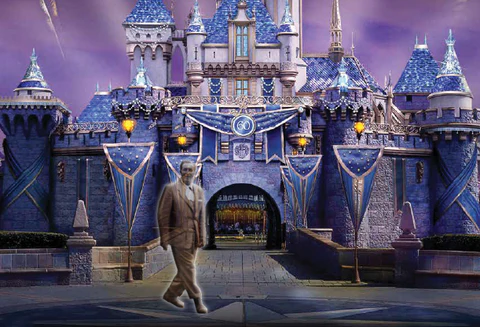
Disney fans have long entertained urban legends surrounding Walt and his continued presence on earth, but two prominent theories have managed to go the distance…
Firstly, fans believe that Walt’s presence continues to linger inside his Disneyland apartment. When you first enter the hallowed gates of The Happiest Place on Earth, you will see the firehouse to your immediate left before you reach Main Street, USA. It was in this quaint building that Disney resided with his family, and would light a lamp in the window of his second story apartment when he was home. Shortly after Walt’s death, the staff member in charge of cleaning Walt’s apartment one night, reported turning off the lamp on the way out of the apartment before locking up and leaving. When she got downstairs, she happened to look up and saw that the lamp was still on. Assuming she had made a mistake, she quickly returned upstairs and switched if off. However, when she got downstairs, the lamp was on again. Upon her return to the apartment for the second time, she switched the lamp off and waited inside when she heard the lamp click and flare back to life. Since the incident, Disneyland has kept the lamp on, claiming that it serves as a tribute to the park’s creator, but it may not be so much a matter of choice, as Walt’s ghostly refusal for his light to be dimmed. Cast members to this day report seeing a shadowy figure passing in front of the window, noises coming from inside the apartment and a continual feeling of being watched from the apartment whenever they are in the vicinity.
The second most famous claim to Walt’s ghost can be seen in a YouTube video which went viral in 2015. The park footage shows a dark, mysterious figure walking around Disneyland California after dark…and in case you were thinking that it was probably just one of the workers, think again. The man in the video glides through the park gates and even walks on water.
5. Sexist Rejection Letter
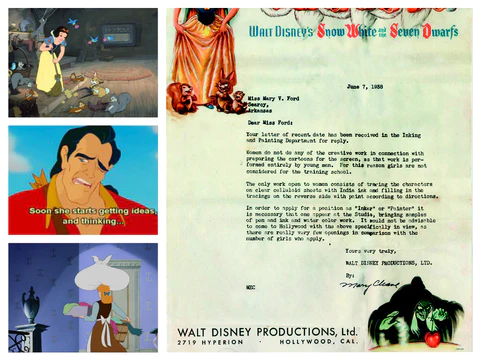
A disturbing rejection letter made famous by Meryl Streep depicts the sexist environment that the company fostered in the earlier years of the animation company.
The 1938 letter (pictured above) was printed on impeccable Snow White stationery and was addressed to a woman – Mary Ford – who had applied for a position on the animation team at the company. The reasons outlined for Miss Ford’s dismissal are due to Disney’s exclusionary policies, as follows:
In the man’s world of the 1930s, Disney made a point of contributing to limiting the dreams of women everywhere by creating a rigid division of labor within the company and encouraging woman to pursue smaller ambitions, rather than those that men were eligible to apply for.
6. Suicide Mouse
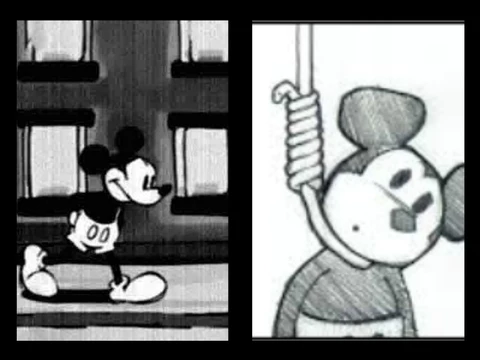
Though the name suggests it was Mickey who met his untimely end, the story of ‘Suicide Mouse’ has a much darker story – one that has become a prominent internet legend in previous years.The disturbing ‘Suicide Mouse’ video is not only rumoured to disturb and distress those who watch it, but it has even been claimed to have caused the death of a film worker who watched it.
According to the urban legend, the film is a ‘lost’ black and white Mickey Mouse cartoon which on watching has a similar animation style to ‘Steamboat Willie’, however, the film is claimed to be a depiction of Mickey Mouse…in Hell.
The film opens with a rather mundane scene depicting Mickey walking across a stagnant city landscape with dull piano noises providing the background audio. After the repetitive scene has played out for two minutes, the screen goes black. Up until recently, it was believed that the cartoon ended there. However, a Disney employee who was sorting cartoons from the 1930s made the mistake of watching the cartoon through to the end.
While the employee was transferring the cartoon into digital copy he realised that the film was actually over 9 minutes long. In the sixth minute of the film, the cartoon suddenly reappears but the background piano noise has been replaced by a bloodcurdling scream. As the cry increases in volume, the picture distorts, with the city landscape warping and stretching across the frame. In the foreground, Mickey’s face appears to curve into a sinister smile before falling apart.
Nobody knows what happens in the film’s last 30 seconds, as only one person has seen the end footage and he did not live to tell the tale. According to eyewitness reports, after finishing the film the employee stumbled out of the film room incoherently slurring ‘real suffering is not known’ before grabbing the pistol of the nearest security guard and taking his own life. After his death, his notes were found in the office which provide the only information in existence as to what is contained in that last 30 seconds: “the sights of Hell bring its viewers back in”.
See the film…if you dare.
Note: Though the original video is said to be 9:31 in duration, the above version cuts out at 9:01
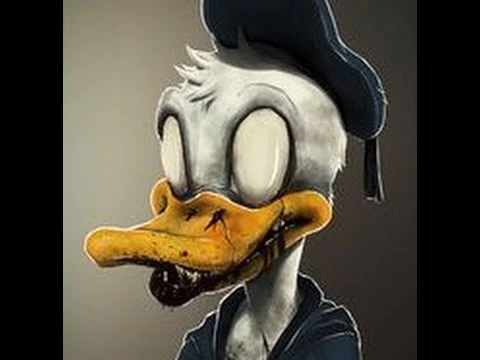
With Disnerds all over the world patiently awaiting the release of Disney’s 2016 films, there seems no better time to take another look at several more disturbing secrets behind the Happiest Place on Earth, the canon of legendary films and the man who created them all: Disney.
From the seemingly shadowy to the outright sinister, we count down six more disturbing Disney secrets….
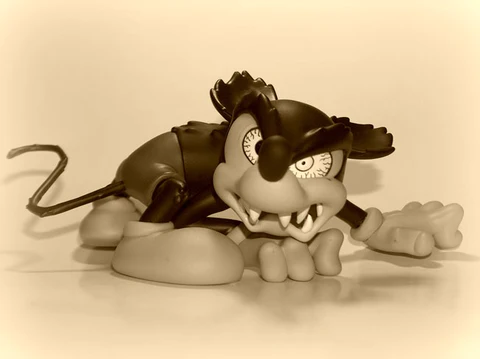
With Halloween coming up, there is no better time to look at some of the disturbing secrets behind the Happiest Place on Earth and its iconic films.
From the dark and disturbing, to the outright bizarre, we count the top seven disturbing Disney secrets.
Undignified Ends
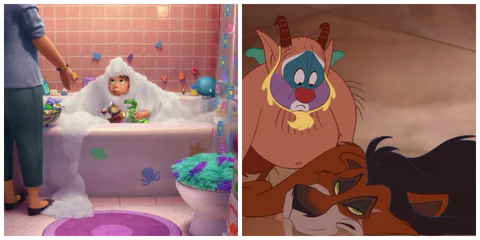
We are used to many of the villains in Disney movies meeting untimely ends, but some characters, appear to get their comeuppance, more than others.
One example is Scar from The Lion King. Scar’s death is implied at the end of the film, but his disturbing cameo in another film is nothing short of horrific. At the beginning of The Lion King, Zazu sarcastically tells Mufasa that Scar would make a handsome throw rug. Three years later, Zazu’s comment comes to fruition when Scar reappears in Hercules as a throw rug. Though it is not unusual for Disney to make light of death when it comes to villains, this one goes too far, making it particularly creepy.
Other disturbing references include a toilet seat cover in Toy Story 3 which has an uncanny resemblance to Sully from Monsters Inc. This is particularly creepy when we remember Randal’s line to Sully in the original movie:
“I heard humans skin monsters and make toilet covers out of their fur”
Gaston’s Death
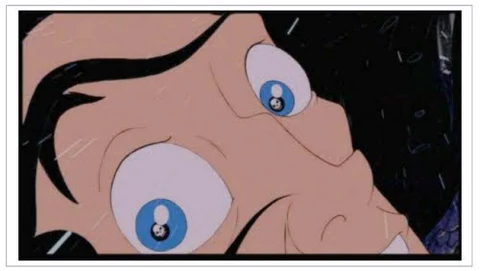
One of the most disturbing scenes from any Disney movie occurs toward the end of Beauty and the Beast, when Gaston plummets to his death of the castle rooftop.
After his showdown with the Beast, Gaston loses his grip on the castle and plunges to the ground – but just before he does, he flashes the Beast a wide-eyed look in which human skulls can be seen in his pupils. Officially, the Walt Disney Company states that the skulls were placed to help viewers feel confident that Gaston’s fate is sealed.
Interestingly, some versions have been altered to remove these skulls.
Mommy Issues

A common question among Disney fans and critics of the film is why so many characters don’t have mothers, or lose them during the film. While theories about this are mainly due to speculation, the official explanation given is usually due to an issue close to Walt’s heart. According to this theory, Walt Disney experienced severe guilt after his mother passed away in the house that he purchased for her. Reportedly, Walt bought his mother the home after his success on Snow White and the Seven Dwarves but his mother died in a fire that was caused by a fault in the furnace of the house. The fire occurred only one month after Walt bought the house and it was due to this that he lived with deep guilt.
Conspiracy theorists argue that Disney has a darker agenda and instead is attempting to reinforce anti-family values.
Mysterious Code
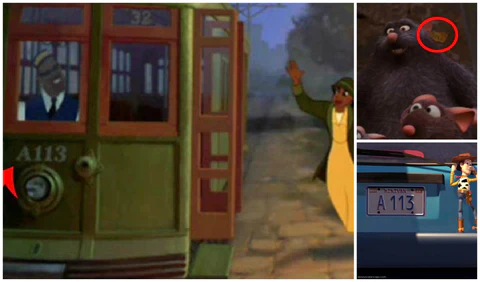
Almost every Disney Pixar movie that has been created since the amalgamation of these two animation partners contains a secret code ‘A113’.
Sometimes tucked away in single frames and sometimes out in plain sight, A113 can be seen in everything from the number plate on Andy’s mother’s car in Toy Story to the class number in Monster’s University to the model number on the camera in Finding Nemo. Officials describe this hidden Easter egg as being attributed to the room at the California Institute of Arts where many of the Disney and Pixar animators were taught, but a darker explanation could be responsible as conspiracy theorists claim that it represents a secret Illuminati code.
Racism
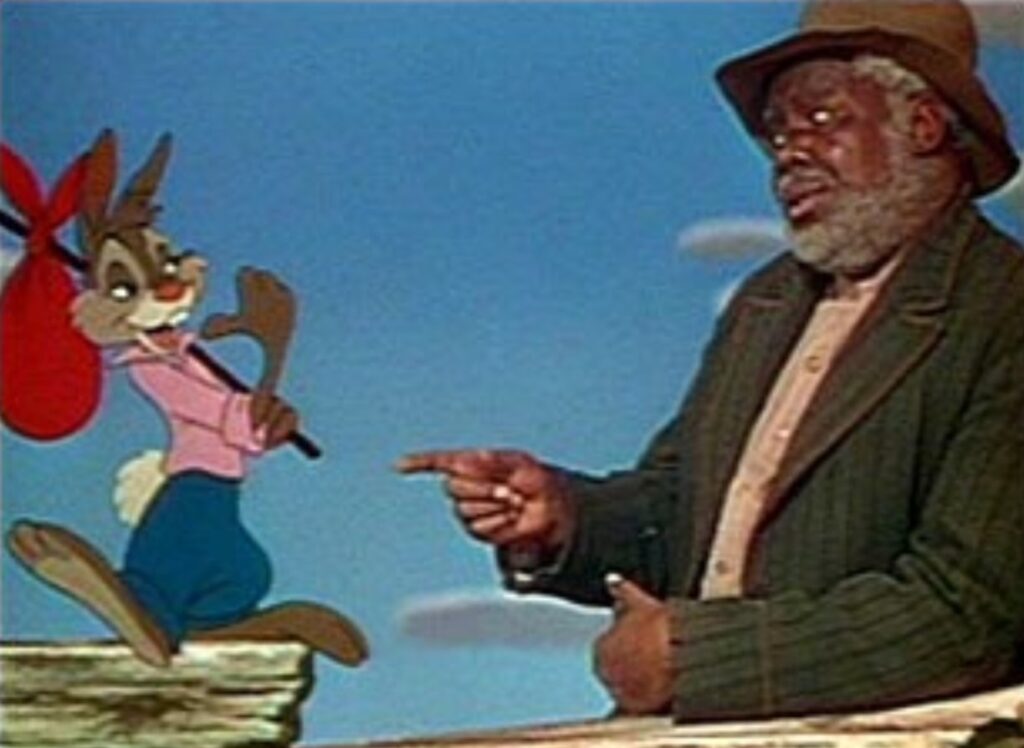
A lot of Disney fans haven’t seen the 1946 musical film Song of the South, but most would be familiar with its famous song ‘Zip-a-Dee-Doo-Dah’ and the Disney ride inspired by the film – splash mountain. While the film is no longer widely viewed, its reputation has lived on…particularly amongst those who feel that the film is insulting to American minorities. The film features a large amount of racial stereotypes and attempts to handle slavery and race-relations in the South of the U.S. as a light-hearted sport. The NAACP even suggested that the film “helps to perpetuate a dangerously glorified picture of slavery.” For this reason the film has never been released on video.
Another concerning display of racism can be found in the original cut of Fantasia where a centaur named ‘Little Sunshine’ once appeared. Sunshine’s character was a half-donkey, half black girl whose sole purpose was to polish the hooves and brush the tails of the other, white centaurettes. Sunshine has not appeared on any release of the film since the 1960s and her existence was even denied until someone posted the footage on the internet recently.
Here’s….Johnny!
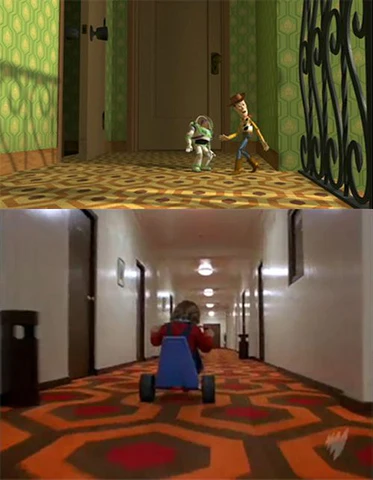
As if Stephen King’s The Shining wasn’t creepy enough, it now invades children’s movies such as Disney Pixar’s Toy Story film series.
Toy Story features several eerie references to this creepy film. The first appears in Toy Story when the carpet in Sid’s house matches that of the Overlook hotel. In Toy Story 3 this same pattern can be seen on a small box on the desk of the surveillance monkey beside the microphone used in The Shining.
The most prominent reference to The Shining is the presence of the number 237 throughout the films, which was the number of the most haunted room at the Overlook Hotel. honorable mentions include number plate of Sid’s garbage truck which read ‘RM237’, the label on the video camera which says ‘Overlook R237’ and the username of Trixie’s online chat friends: velociraptor237.
While the references in Toy Story 3 can be attributed to the director’s passion for The Shining, Disney fans everywhere are baffled as to how the one in Toy Story made the cut…
Sexual References
Hidden Images and Messages in Disney’s “The Little Mermaid”
Phallus in the Palace
Okay, okay. We might as well get it out of the way first: the famous “penis” in The Little Mermaid movie poster. This is one of the most famous and one of the most debated Disney “goofs” (no pun intended).
The story goes like this: A disgruntled artist working on the film was fired. But before he left, he got his revenge by drawing a penis in Tritan’s castle. The phallic image went unnoticed by Disney and soon, children across the world were bringing home VHS tapes with this “artwork.”
Disney claims that the “penis” was not the result of an angry former employee and simply states that the image was just a coincidence.
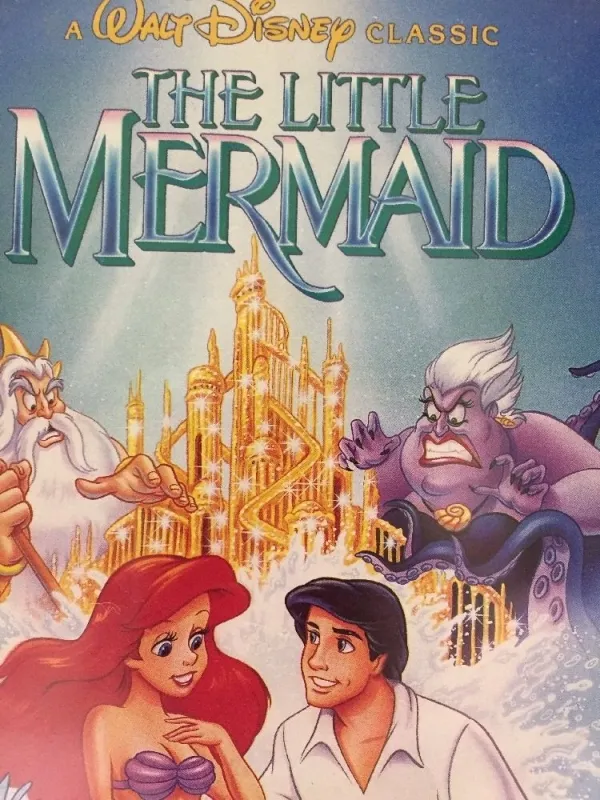
The plain truth is that the resemblance between the castle spire and a penis was purely accidental, and it was drawn by an artist who was neither disgruntled nor about to be dismissed.
First of all, the artist who created the video cover art did not work for Disney itself, thus he was neither “disgruntled with Disney” nor “about to be fired.” We questioned the artist, who also drew artwork for Little Mermaid theatrical advertising, pop-ups, greeting cards, Happy Meal boxes, and CDs. The theatrical posters were done before the original release of the film, but the video cover art was not created until a few months before the home video version hit the market. Rushed to complete the video artwork (featuring towers that were rather phallic to begin with), the artist hurried through the background detail (at “about four in the morning”) and inadvertently drew one spire that bore a rather close resemblance to a penis:
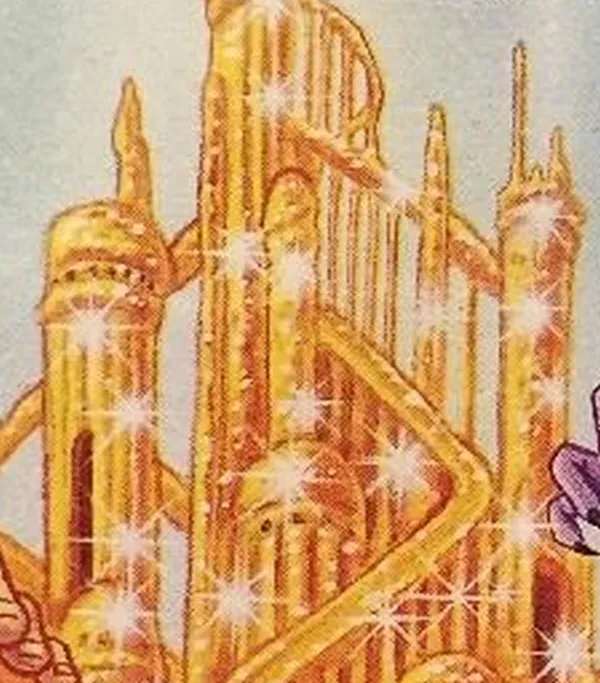
The artist himself didn’t notice the resemblance until a member of his youth church group heard about the controversy on talk radio and called him at his studio with the news.
The later laserdisc release of the film was issued with a cover containing an altered version of the infamous spire. Contrary to common belief, the phallic-like spire did not make its first appearance with the cover to the home video version; the same background drawing of the castle, with the same spires, appeared in promotional material and posters that accompanied the film’s original theatrical release. The video cover does differ slightly from the original version, but the castle shown in the background is the same in both versions. (Later versions of the laserdisc cover were altered to remove the offending spire.)
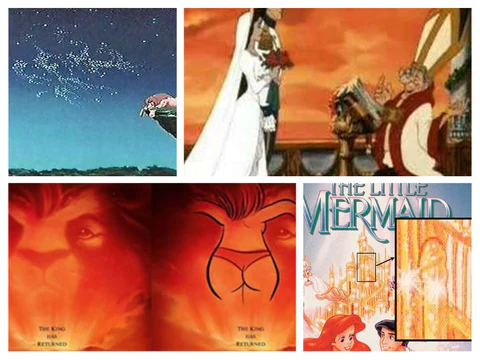
The internet is full of videos and blogs about the hidden (and not-so-hidden) messages embedded into Disney films. The following are the most prominent sexual references in Disney films:
The Little Mermaid. Not only did the original publicity material contain phallic imagery, but the Bishop who oversees the wedding in the film is also well known for the bulge evident in his pants. While officials claim that the bulge was only the knee of the Bishop, it is interesting that when the DVD was re-released, the Bishop was missing his pants tent as it has been digitally removed.
The Rescuers. In two frames of the film, a woman appears in the window of an apartment wearing no top. Rumour has it that animators included the frames as a nod to Playboy and its iconic centrefolds and intended for it to be a private joke, but when public outcry broke out among parents, Disney recalled over three million copies of the movie and issued an official apology.
The Lion King. In a scene depicting Simba collapsing on the edge of the cliff, there is a scattering of pollen seen. Though the Walt Disney Co. insists that the pollen comes together in the sky to spell the letters ‘SFX’ (a reference to special effects) most agree that the word clearly spells ‘sex’.
Aladdin. In the 1992 film, there is a scene where Aladdin and Jasmine are talking on the balcony. When the shot cuts away from Aladdin, he can be heard muttering a sentence which sounds uncannily like ‘Good teenagers – take off your clothes!’ According to the director’s commentary, the line is actually ‘Good kitty. Take off and go’. Curiously, this innocent line was edited out of all future DVD releases.
Who Framed Roger Rabbit? The famous sex symbol Jessica Rabbit has a major wardrobe malfunction in this racy film. Thinking it would be entertaining, animator’s snuck a few frames into the film of Jessica showing what she had for breakfast. In the scene where the car crashes and Jessica is thrown from the car, her crotch is shown briefly under her dress. In later releases of the film, Jessica’s character was digitally altered to add white underwear.
The “phallic symbol” in The Little Mermaid’s artwork went undetected by the general public for about a year while the film was in the theatrical release. Shortly after Entertainment Weekly ran a story about the offending artwork in mid-1990, the rumor became widespread when Machelle Couch of Mesa, Arizona, complained to Disney and a Phoenix supermarket chain (Bashas’) about the phallus on the cover of The Little Mermaid. Bashas’ pulled the videos from their shelves (but returned them less than 24 hours later), and the story of the “penis” cover was soon widely disseminated by the media.
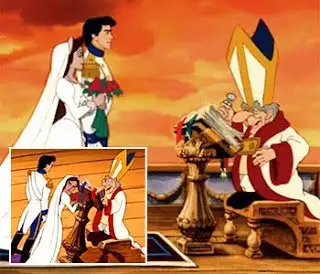
The Perverted Priest
It seems like penises are starting to become a theme with The Little Mermaid. Yet another highly debated image is during Eric and Vanessa’s (Ursula) wedding scene: the Priest seems to be the happiest out of everyone. If you look closely, it appears that the Priest is getting a boner throughout the ceremony. The “bump” comes and goes throughout the scene, but is clearly visible.
Disney came out saying that the “bump” is nothing more than the Priest’s knee(s). Looking at the picture below, it’s debatable. When I first saw the bump, I was skeptical as to whether the “bump” was his knee or a hidden joke left by an animator. But after looking at the smaller picture within the picture below, it appears that he has two “bumps,” further supporting the knee theory.
However, again, I leave it up to you to decide. Either way, the artist probably should’ve been more careful.
https://hourloop.com/blogs/news/88796161-disney-after-dark-6-more-disturbing-disney-secrets
https://hourloop.com/blogs/news/51478017-7-disturbing-disney-secrets
https://reelrundown.com/animation/What-You-Didnt-See-HIdden-Disney-Images-The-Little-Mermaid
https://www.snopes.com/fact-check/phallus-purposely-added-artwork-little-mermaid-vhs-cover/
